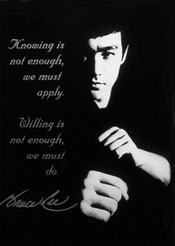Jeet Kune Do five Types of Speed
Speed Training of Jeet Kune Do
#1.Perception speed. When fighting, martial artists must constantly sense and respond to various stimuli. Mastering the ability to perceive the subtleties in an opponent's movements, is he attacking, retreating, punching or kicking? Is the first phase of speed training. Simply seeing the opponent's movements is not enough. You must learn to hear, feel and see the opponent's intentions. Perception speed is defined as the time it takes you to mentally register the opponent's intentions once you first sense his offensive or defensive stimulus. To increase your speed of perception, it is important to maintain an attitude of "emptiness," or what Bruce Lee called "no-mindedness." You must learn not to concentrate too much on details. Look at nothing, but sense everything. (The art of seeing without looking) According to Lee, "A concentrated mind is not an attentive mind, but a mind that is in the state of awareness can concentrate. Awareness is never exclusive, it includes everything. A mind must be wide open to function freely in thought."
#2.Mental/decision speed. Once you have sensed the opponent's intention, or when the opponent has stimulated your awareness you must decide how to respond. Do you evade, block, parry, jam, intercept or counter his attack? Your decision speed is determined by the length of time it takes you to sense the opponent's stimulus and select an appropriate response. Your ultimate goal is to be able to respond quickly and instinctively. (Jeet means to intercept) In jeet kune do we train this by doing thousands of repetitions and countless hours of awareness training drills.
#3.Initiation speed. The time that it takes to transfer your decision to punch from the brain to your fist, and actually begin the punch is your initiation speed. You must condition yourself to relay the opponent's stimulus to your brain, and then to your striking or defending tools as quickly as possible. With a completed action. The slightest hesitation can mean the difference between life or death, hitting, or being hit by, the opponent. Never hold back. If you do not wish to harm your opponent run. If you cannot run do not hold back “ WIN “. Let it take over.
#4.Performance speed. Once your response decision has been converted into an initial movement, the time it takes you to get from point "A" to point "B" is your performance speed. You can have a very fast perception, decision or initiation speed in a confrontation, but if your tools travel like a low speeded gearbox or a turtle, your chances of striking the opponent are minimal. You must train all tools and movements until they become natural movements with no restrictions and use the principles of jeet kune do.
#5.Alteration speed. Sijo: Bruce Lee defined alteration speed as "the ability to change direction midstream." In the ever-changing conditions of a fight. There is always the potential to make a wrong decision or dangerous mistake. However if you do not posses the ability to change direction in midstream or you freeze up in any such situations, you have a strong chance being defeated by your opponent or getting hit. However If you Have trained yourself to posses a good alteration speed, you can overcome your mistake with a reflexive adjustment, or correction and still strike your opponent. In jeet kune do again we accomplish this by thousands of repetitions, and countless hours of training drills also applying the principles of Jeet Kune Do. All while maintaining an open and clear mind.
Friends – the groundwork has already been laid by our Sijo: Bruce Lee this is merely an explanation of how I perceive what has already been written.I Hope it help’s better understand how to use and apply the five types of speed. Training drill's and techniques for building speed are coming next.Along with many how to tip's.
Sifu:Danny Shirley
These pages are still under construction
(lots more to come about this topic and others)
Sunday, December 16, 2007
Subscribe to:
Post Comments (Atom)



No comments:
Post a Comment